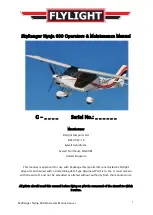
9
ENGLISH
Spiral Dives
If you turn your glider in a series of tightening 360’s it will enter a spiral dive.
This will result in rapid height loss. To initiate a spiral, look and lean in to the
direction you want to go, then smoothly pull down on the inside brake. The
Mojo4 will first turn almost 360 degrees before it drops into the spiral. Once
in the spiral you should re-centre your weight shift and apply a little outside
brake to keep the outer wing tip pressured and inflated.
Safe descent rates of 8m/s (1600 ft/min approx.) are possible in a spiral
dive, but at these rates the associated high speeds and G-forces can be
disorientating, so pay particular attention to your altitude.
To exit the spiral dive, ensure your weight shift is in a centred position and
then slowly release the inside brake. As the Mojo4 decelerates allow it to
continue to turn until enough energy is lost for it to return to level flight
without an excessive climb and surge.
The Mojo4 shows no tendency to remain locked in a spiral dive; however
some parameters could interfere with its behaviour. These might include:
wrong settings of the chest strap, total weight in flight outside of the certi-
fied weight range, or being in a very deep spiral at a very high sink rate. You
should always be prepared to pilot the wing out of such a spiral dive. To do
so, smoothly use opposite weight shift and apply a small amount of outside
brake and the glider will start to resume normal flight. Never attempt to
recover from a spiral with hard or quick opposite inputs as this will result in
an aggressive climb and surge.
IMPORTANT: Spiral dives with sink rates over 8 m/s are
possible, but should be avoided. They are dangerous and
put unnecessary strain on the glider. Spiral dives cause
disorientation and need time and height to recover. Do not
perform this manoeuvre near the ground.
ADVANCED FLIGHT TECHNIQUES
Rapid Descent Techniques
Ozone would like to remind you that these manoeuvres should be learnt
under the supervision of a qualified instructor and always used with caution.
Never forget that properly analysing the conditions before launch will help
avoid the need to use these techniques.
Big Ears
Folding in the wingtips increases the wing’s sink rate. This is useful for stay-
ing out of cloud or descending quickly. To pull big ears, keep hold of your
brake handles and take the outermost A-line on each side, then pull down
(preferably one at a time) until the tips of the wing fold under. The Outer A
line is attached to the Baby A riser, making identification and use of the big
ear system easier.
Do not use the brakes other than for re-inflation. For directional control
while using the Big Ears, you should use weight shift.
To reopen your big ears, release both A lines at the same time. To help
reinflation, brake gently one side at a time until tips regain pressure. Avoid
deep symmetric applications of the brake as this could induce parachutal or
full stalls.
IMPORTANT: You can land with the ears (you should release
the ears before final flare). Ozone do not advise you to do
this when it’s turbulent or windy due to the risk of a possi-
ble stall and lack of precision in steering.
Big ears and accelerator
Once the big ears are in you can further increase the sink rate by pushing on
the accelerator bar.
IMPORTANT NEVER induce Big Ears with the speed bar en-
gaged, this can provoke a major deflation. Always make Big
Ears first and THEN apply the speed bar.












































